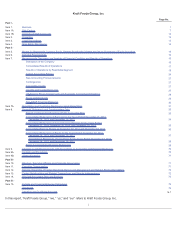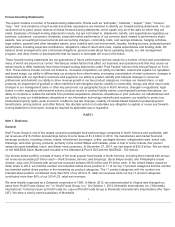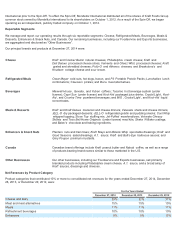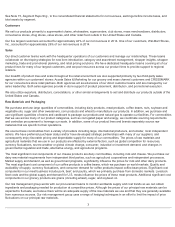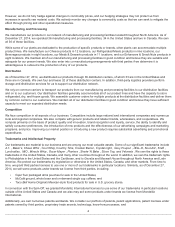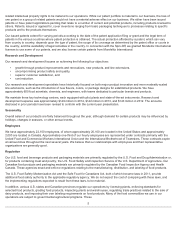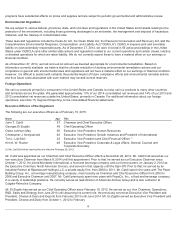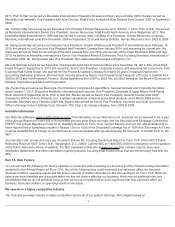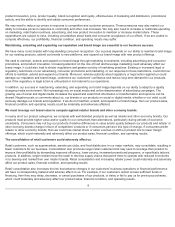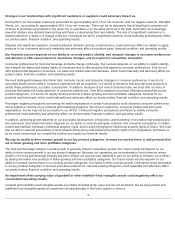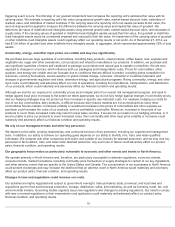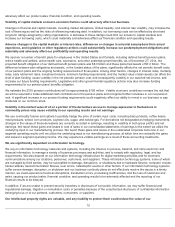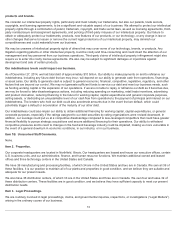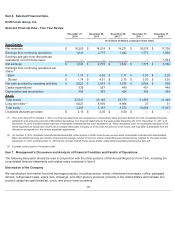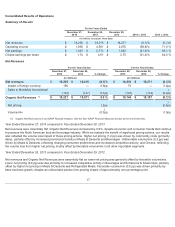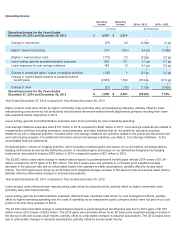Kraft 2014 Annual Report Download - page 13
Download and view the complete annual report
Please find page 13 of the 2014 Kraft annual report below. You can navigate through the pages in the report by either clicking on the pages listed below, or by using the keyword search tool below to find specific information within the annual report.
Changes in our relationships with significant customers or suppliers could adversely impact us.
During 2014, our five largest customers accounted for approximately 42% of our net revenues, with our largest customer, Wal-Mart
Stores, Inc., accounting for approximately 26% of our net revenues. There can be no assurance that all significant customers will
continue to purchase our products in the same mix or quantities or on the same terms as in the past, particularly as increasingly
powerful retailers may demand lower pricing and focus on developing their own brands. The loss of a significant customer or a
material reduction in sales or a change in the mix of products we sell to a significant customer could materially and adversely affect
our product sales, financial condition, and operating results.
Disputes with significant suppliers, including disputes related to pricing or performance, could adversely affect our ability to supply
products to our customers and could materially and adversely affect our product sales, financial condition, and operating results.
Our financial success depends on our ability to correctly predict, identify, and interpret changes in consumer preferences
and demand, to offer new products to meet those changes, and to respond to competitive innovation.
Consumer preferences for food and beverage products change continually. Our success depends on our ability to predict, identify,
and interpret the tastes and dietary habits of consumers and to offer products that appeal to consumer preferences. If we do not
offer products that appeal to consumers, our sales and market share will decrease, which could materially and adversely affect our
product sales, financial condition, and operating results.
We must distinguish between short-term fads, mid-term trends, and long-term changes in consumer preferences. If we do not
accurately predict which shifts in consumer preferences will be long-term, or if we fail to introduce new and improved products to
satisfy those preferences, our sales could decline. In addition, because of our varied consumer base, we must offer an array of
products that satisfy the broad spectrum of consumer preferences. If we fail to expand our product offerings successfully across
product categories, or if we do not rapidly develop products in faster growing and more profitable categories, demand for our
products could decrease, which could materially and adversely affect our product sales, financial condition, and operating results.
Prolonged negative perceptions concerning the health implications of certain food products could influence consumer preferences
and acceptance of some of our products and marketing programs. We strive to respond to consumer preferences and social
expectations, but we may not be successful in our efforts. Continued negative perceptions and failure to satisfy consumer
preferences could materially and adversely affect our product sales, financial condition, and operating results.
In addition, achieving growth depends on our successful development, introduction, and marketing of innovative new products and
line extensions. Successful innovation depends on our ability to correctly anticipate customer and consumer acceptance, to obtain,
protect and maintain necessary intellectual property rights, and to avoid infringing the intellectual property rights of others. We must
also be able to respond successfully to technological advances by and intellectual property rights of our competitors, and failure to
do so could compromise our competitive position and impact our financial results.
We may be unable to drive revenue growth in our key product categories, increase our market share, or add products that
are in faster growing and more profitable categories.
The food and beverage industry’s overall growth is generally linked to population growth. Our future results will depend on our
ability to drive revenue growth in our key product categories. Because our operations are concentrated in North America, where
growth in the food and beverage industry has been limited, our success also depends in part on our ability to enhance our portfolio
by adding innovative new products in faster growing and more profitable categories. Our future results will also depend on our
ability to increase market share in our existing product categories. Our failure to drive revenue growth, limit market share decreases
in our key product categories or develop innovative products for new and existing categories could materially and adversely affect
our product sales, financial condition, and operating results.
An impairment of the carrying value of goodwill or other indefinite-lived intangible assets could negatively affect our
consolidated operating results.
Goodwill and indefinite-lived intangible assets are initially recorded at fair value and are not amortized, but we test goodwill and
indefinite-lived intangible assets for impairment at least annually in the fourth quarter or when a
9


